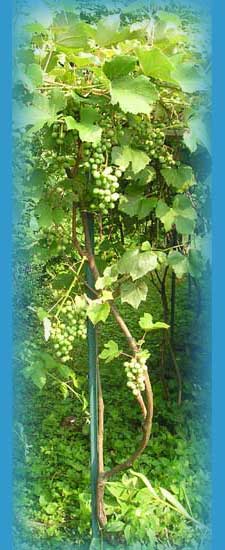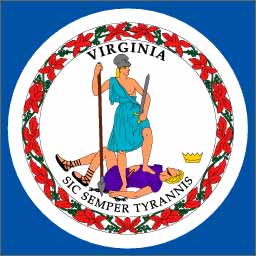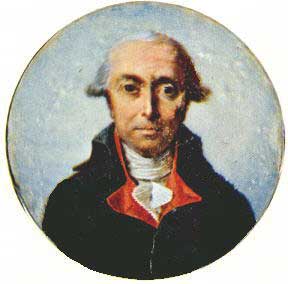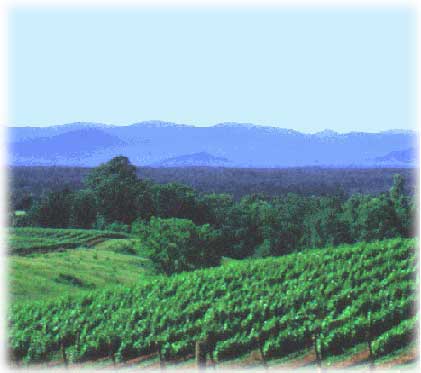|
|
|
The Washington Winemakers |
|
Home What's New About Us Learn To Make Wine The Wines of Italy Suppliers Wines and Grape growing in Virginia and Maryland Contact us  The Abruzzo and Molise Heritage Society of the Washington DC Area  |
Our list of selected websites below is not to be taken as an indication of sponsorship of any commercial enterprise, and is solely presented as information for those interested in wines and grapegrowing.

|
|
extracted from www.virginiawinewine.org 
 Virginia Wine History -As soon as they set up the Jamestown colony in 1607, English settlers were already thinking about production of wine. There was a ready market for it back across the sea, and great riches could be expected for successful winemakers. The first wine was produced in 1609 from native grapes, and in 1611 vineyard specialists arrived from the Mother Country which was anxious to establish winemaking in the colony.
Virginia Wine History -As soon as they set up the Jamestown colony in 1607, English settlers were already thinking about production of wine. There was a ready market for it back across the sea, and great riches could be expected for successful winemakers. The first wine was produced in 1609 from native grapes, and in 1611 vineyard specialists arrived from the Mother Country which was anxious to establish winemaking in the colony.
Thus began two centuries of frustration in producing wine in the colony, despite official encouragement such as the 1624 Requirement by the House requiring that 20 vines be planted for each male colonist above age 20. The colonies even brought in French viticulturists who, however, failed for two centuries to transplant European viticulture to the New World. Yet, in 1769 on the eve of the American Revolution, the Virginia Assembly appointed a French vineyardist, Andrew Estave, as winemaker and viticulturist for the colony. Like all before him, Estave failed. Still, even in failure, Estave reached a conclusion that, by the turn of the century, was widely accepted and would lead to development of a strong wine industry in Virginia. Estave's conclusion was that the problem was in the grapes, that the European vitus vinifera grapes were too fragile for the American climate. Instead, he believed native American grapes would flourish in the Virginia climate of cold winters and hot, humid summers. Philip Mazzei  Enter Thomas Jefferson who was anxious to see winemaking develop in America both for its pleasing qualities and as an alternative crop to lessen the colony's dependence on tobacco, the number one cash crop in Virginia. To further that aim, in 1773 he gave 2,000 acres to his friend, Philip Mazzei a Florentine, who also believed native grapes must be the foundation of successful winemaking.
in 1773 Mazzei settled in Virginia with twelve Italian farmers, in order to start an agricultural enterprise. Initially the Italian farmers successfully transplanted the hundreds of fruit trees and vine grafts they had brought from Tuscany; but in May 1774 an unprecedented freeze destroyed a good part of what they had expectantly cultivated.
Enter Thomas Jefferson who was anxious to see winemaking develop in America both for its pleasing qualities and as an alternative crop to lessen the colony's dependence on tobacco, the number one cash crop in Virginia. To further that aim, in 1773 he gave 2,000 acres to his friend, Philip Mazzei a Florentine, who also believed native grapes must be the foundation of successful winemaking.
in 1773 Mazzei settled in Virginia with twelve Italian farmers, in order to start an agricultural enterprise. Initially the Italian farmers successfully transplanted the hundreds of fruit trees and vine grafts they had brought from Tuscany; but in May 1774 an unprecedented freeze destroyed a good part of what they had expectantly cultivated.
Though Mazzei's efforts later on were interrupted by the Revolutionary War and never resumed, Jefferson continued his study and love of wines. He became a wine advisor to several American presidents and, at George Washington's request, selected the first wines to be stocked in the White House. Perhaps most important, as Ambassador to France, he visited and closely studied the winemaking areas of Italy and France and returned home an even more enthusiastic ambassador of wines. In an era when harder spirits were the custom, Jefferson firmly believed wines were a healthier beverage--a conclusion reached by numerous modern studies. He commented: "In countries which use ardent spirits, drunkenness is the mortal vice; but in those countries which make wine for common use, you never see a drunkard." More pointedly, Jefferson said: "No nation is drunken where wine is cheap and none sober where the dearness of wine substitutes ardent spirits as the common beverage." While he appreciated European wines, Jefferson agreed with Mazzei and Estave that an American winemaking industry would depend upon native American grapes rather than European varieties. Others had reached the same conclusion and, by 1800, Virginians had turned to development of hybrids of American and European varieties, resulting in grapes that combined American hardiness with European finesse and complexity. The most popular were the Alexander, Norton, Catawba, Isabella, Niagara, Concord, and Delaware--all of which are still grown today. Between 1800 and the outbreak of the War Between the States, a strong winemaking industry developed in Virginia. Unfortunately, with so many fierce battles on Virginia soil during the war, vineyards were destroyed with the rest of the economy, leaving winemakers in no position to compete with other wines that began flooding the market, especially from California. In the later 1800s, Prohibition sentiment gained in Virginia, further retarding the revival of winemaking and, by the time Virginia voted dry in 1914, few vineyards were left in the state. In 1950, only 15 acres of grapes were being grown, mostly for table consumption. In the 1960s, after half a century of dormancy, the Virginia grape industry began a revival that, in only 25 years, has made it the 11th largest wine producer in the country. The revival resulted from an increasing national appetite for wine, a built-in market in metropolitan areas, and the receptivity of farmers to alternative crops. Combining these factors with favorable growing conditions, a new era of winemaking began in the Old Dominion. The revival in the 1960s began with American hybrids. By the 70s, the emphasis had shifted to French hybrids. Another crucial shift occurred in the early 70s with the cultivation of vinifera varietals that would appeal to more sophisticated palates. By 1982 vinifera varietals had become the predominant choice of grape growers, producing what have become the most popular Virginia wines: Chardonnay, Riesling, and Cabernet Sauvignon. Also growing in popularity is another vinifera varietal, Merlot. The most popular French hybrids are Seyval and Vidal. Not surprisingly, other varietals are gaining prominence as the demand for Virginia wines grows in response to the industry's ability to successfully produce top grade wines. One of the most crucial elements in the tremendous growth of the Virginia wine industry has been a favorable official climate as exemplified in the Farm Winery Law of 1980. One of the most significant provisions of the law is that, to qualify as a farm winery, at least 51% of its wine must be produced from grapes owned or leased by the winery. Among the many benefits of this provision is that wineries may sell wine at both the wholesale and retail levels without additional licenses. Other official encouragement came during the 80s when both the state and USDA initiated successful programs through Virginia Tech to help improve the growing of wine grapes and the palatability of Virginia wines. Tech's work on behalf of the wine industry has reaped large dividends in improvement of the industry as well as the stability of individual wineries. In addition, the Virginia Wine Marketing Board works with the Virginia Department of Agriculture and Consumer Services to promote the wine industry. Today Virginia wines are winning not only national but international acclaim. To appreciate this accomplishment, it is important to remember Virginia, in effect, had no wine industry until the mid-70s. It faces world-class competition from California and Europe, yet has managed not only to survive but to become the eleventh largest wine-producing state in the nation. This has come through learning more about weather and local conditions, allowing vineyardists to develop hardier strains to thrive in the more variable and challenging Virginia climate.  In fact, the variations from the Blue Ridge to the Eastern Shore produce variable vintages with the sensory difference in taste and flavor that increase the appeal of Virginia wines. The identification of particular wines with specific regions has acted as a boon to the state's important tourism industry, drawing hundreds of thousands of visitors to wineries and festivals all over the state. So 350 years after the first colonists at Jamestown did their mightiest to establish a viable wine industry in Virginia, those early dreams and frustrations have come to fruition in wineries flourishing across the Old Dominion. Hundreds of years later, His Royal Majesty, the London Company, and Thomas Jefferson would doubtless be proud, even amazed, at the place Virginia wines are gaining throughout the nation and the world.
In fact, the variations from the Blue Ridge to the Eastern Shore produce variable vintages with the sensory difference in taste and flavor that increase the appeal of Virginia wines. The identification of particular wines with specific regions has acted as a boon to the state's important tourism industry, drawing hundreds of thousands of visitors to wineries and festivals all over the state. So 350 years after the first colonists at Jamestown did their mightiest to establish a viable wine industry in Virginia, those early dreams and frustrations have come to fruition in wineries flourishing across the Old Dominion. Hundreds of years later, His Royal Majesty, the London Company, and Thomas Jefferson would doubtless be proud, even amazed, at the place Virginia wines are gaining throughout the nation and the world.
In 2003 more than 80 licensed farm wineries werre in production, and most of them are open to the public for tours and tastings. In 1979, Virginia had just six wineries, and a little over 15 years ago a total of 29 wineries were producing 75,000 cases of wine. By 2001, the Commonwealth's wine industry had grown to 75 wineries, producing more than 285,000 cases of wine. And the industry continues to expand. Virginia’s wines continue to garner national and international awards, including a “Best of Show” in a California competition. Virginia wines can be found throughout the state in retail outlets, restaurants and at festivals and special events. Wines can also be purchased directly at the wineries.
White Wines
A list of Virginia Wineries
 TOP TOP extracted from www.marylandwine.com
 TOP TOP |